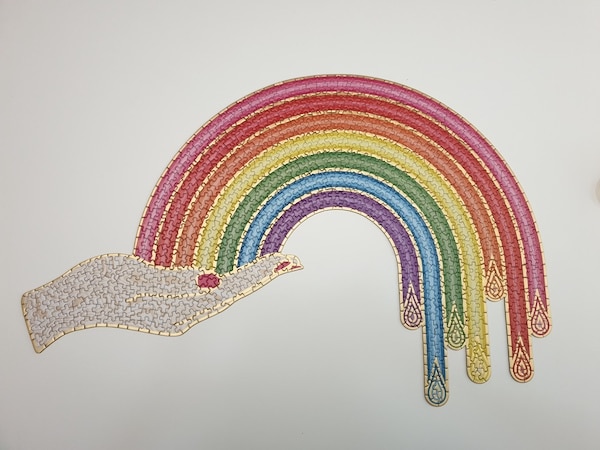My first day back at Magenta after 6-months in full-time mum mode was emotional. I walked into the office, an experience in itself, and the first thing I spotted was the jigsaw the team had assembled, almost complete, except for the missing pieces that were posted to me a month prior so I could finish the puzzle upon my return. The second thing I saw was the ‘Welcome Back’ sign and the photos of team days past. I smiled remembering those shared experiences that didn’t involve a computer screen.

When I left the business to have a baby, we were only just coming out of lockdown. The office wasn’t being used and so I spent the last months of pregnancy waddling to my home office rather than to the Magenta Towers, looking into 2D faces, and craving the energy of in-person meetings. Fast-forward six months and here we are, back together again on a Monday. Back to office banter, laughter, proper coffee, and tongue-in-cheek fights about the music.
The world has started turning again, hurrah, but that doesn’t mean we’re back to where we were pre-March 2020. Life remains changed. So, it’s not welcome back, it’s welcome forward. Welcome forward to a new way of being. If ever there was a time to challenge and change the course of work and workplace, it’s now.
The future of work
According to CBRE’s Global Occupancy Insights 2021 report, the majority of occupiers are moving to hybrid models, redesigning spaces in the process. Elsewhere, research suggests that a significant number of employees want to work from home, at least for some of the week. That’s perhaps one of the reasons why a whopping 71 per cent of occupiers have mobility programmes that enable employees to work from anywhere, according to CBRE’s latest report.
Where some firms have made decisions about what the future of work looks like to them, others are waiting in the wings, editing their script, not quite ready to step into the spotlight. And fair enough, the corporate property sector is still in flux after all. But when the time comes, it’s important to communicate the plan clearly to ensure everyone’s on board.
Here are the seven dos and don’ts of workplace communications best practice.
DOs of workplace communications

- Before you start any communication, it’s essential to know as much as possible about the planned project. Not all the information may be available at the beginning, so make a note of what’s missing and prepare answers to the following questions:
- What’s going to happen?
- What’s going to change?
- Why are we doing this?
- When’s it going to happen?
- How will the workplace change happen?
- Where is it happening?
- Who will be affected?
- Once you know the plan, commit to it, believe in it, and make it happen. Appoint a comms project manager who can ensure communications are timely so rumours don’t start.
- Communicate often in bitesize chunks. There is no such thing as communicating too much as people will easily miss messages.
- Use a variety of tools and channels – not everyone will go to the microsite, open an e-newsletter or read a poster or table-talker, so use a mixture of different channels to reach everyone.
DON’Ts of workplace communications
- Go too deep too quickly. You need to gradually share information so that people are not bombarded with too much unnecessary detail early on.
- Fail to plan for any resistance. By having key messages and answers ready for any difficult questions, you won’t be caught on the back foot.
- Don’t stop communicating once the project is complete. Get feedback on how people feel about the changes and use that information to improve.
Summary
Failing to adhere to workplace communications best practice can be the difference between a project’s success or failure. Make sure you develop a strong communications plan, and bring in expert support if you need it.
Magenta offers expert guidance on workplace communications. Download one of our free workplace communications guides or get in touch to discuss how we can support your business.









